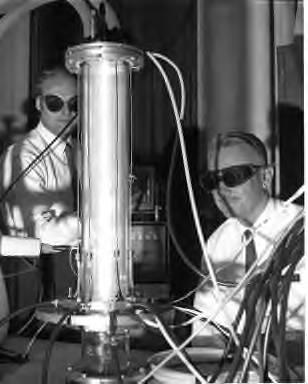
home •
about •
essential guide •
picture of the day •
thunderblogs •
news •
multimedia •
predictions •
products •
get involved •
contact
picture of the day archive subject index
Wesley Doggett (left) and Willard Bennett (right) with Störmertron tube.
Credit: NCSU Special Collections Archive
Jun 13, 2008
Happy Birthday Willard BennettWillard Harrison Bennett, a notable scientist and inventor and for whom the Bennett pinch, or “z-pinch,” is named, was born June 13, 1903.
As a jet of water flows, the surface tension causes the stream to constrict, and the jet forms beads or droplets. One sometimes sees this in a stream of water from a garden hose.
In 1992, Chief Researcher at the Kurchatov Institute, Boris Trubnikov, noted that water beading is a good analogy for the observed pinching of plasma jets in the laboratory as well as the pinching of cosmic plasma in nebulae. In plasma, the pinching is due to the self-generated magnetic field compressing the jet unevenly along its length. The pinch is sometimes called a z-pinch because the magnetic field lies along the z-axis and the beading is sometimes referred to as a sausage instability because of its shape.
In 1905, James Arthur Pollock and Samuel Barraclough at the University of Sydney proposed that the distortions in a length of copper piping used as a lightning conductor were due to the pinch effect. The phenomenon has also been suggested to be the cause for pinching in bead lightning.
Pinching metal is demonstrated in the laboratory by placing an aluminum can in a coil of wire and sending a short pulse of high electric current through the coil. The magnetic field that is generated will crush the can into a characteristic hourglass shape.
As cells of cosmic plasma move relative to each other they generate currents and magnetic fields that also cause them to produce jets that pinch and bead.It is perhaps no coincidence that when astronomer Walter Baade first distinguished individual stars in the Andromeda Galaxy’s core he described them as like "beads on a string". The Ant Nebula, which glows like a plasma-filled fluorescent light tube, has a characteristic hourglass pinch in its middle.
Willard Harrison Bennett first investigated pinches in plasmas in the 1930s. He was able to work out a relationship between the plasma density and current (the so-called Bennett relation), and pinches are sometimes called a Bennett pinch.
Bennett also invented a device called the Störmertron tube. With it, he created analogues for all the plasma stream formations in space, including the toroids of charged particles known as the Van Allen radiation belts that surround Earth. Dr. Willard H. Bennett was inducted into the National Inventors Hall of Fame in 1991 for his invention of the Bennett radio frequency mass spectrometer.
Contributed by Ian Tresman
___________________________________________________________________________
Please visit our Forum
The Electric Sky and The Electric Universe available now!

|
|

|
EXECUTIVE EDITORS:
David Talbott, Wallace Thornhill
MANAGING EDITORS:
Steve Smith, Mel Acheson
CONTRIBUTING EDITORS: Michael Armstrong, Dwardu Cardona,
Ev Cochrane,
C.J. Ransom, Don Scott, Rens van der Sluijs, Ian Tresman
WEBMASTER: Brian Talbott
Copyright 2008: thunderbolts.info
![]()
home •
thunderblogs •
forum •
picture of the day •
resources •
team •
updates •
contact us

